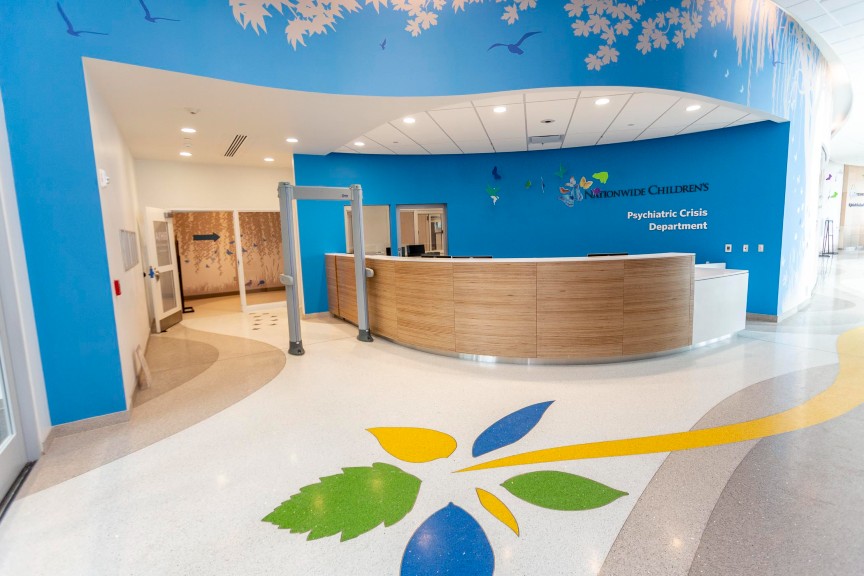The New Emergency Department — for Behavioral Health

From attention deficit disorder to anxiety or depression, mental health conditions affect about 1 in every 5 children. While some of these cases resolve, many children go on to adulthood with mental or behavioral health disorders, and continue to suffer problems at home, school, work and in their social lives.
To make matters worse, numerous conditions — and their sequelae — are on the rise. According to the Centers for Disease Control and Prevention, incidence of depression and anxiety is growing among children ages 6-17. After accidents, suicide is the leading cause of death among kids 10 and older.
And of course, as in any health-related emergency, many families turn to the emergency department for care. From 2011 to 2015, more than 13 million youth (ages 6-24) presented to the ED with a psychiatric concern, according to a 2019 publication in Pediatrics. Unfortunately, more than half remained at the ED for 3 hours or more, and the vast majority (84%) were discharged without seeing any mental health professional.
A 2020 study in Pediatrics from Rachel Stanley, MD, division chief for Emergency Medicine at Nationwide Children’s Hospital, showed that in the period from 2007 to 2016, pediatric ED visits for deliberate self-harm rose 329% and visits for all mental health disorders rose 60%.
The Problem With a Standard ED
While emergency departments should always be an option to treat young people in crisis (especially those in true medical emergency situations), they’re not often the best care solution. The vast majority of young people coming into EDs in a behavioral health crisis do not need medical care — they haven’t physically injured themselves and do not require clinical care for coexisting health conditions. Furthermore, more than 80% do not require hospital admission or transfer to an inpatient psychiatric facility.
Regardless, patients and their families sit in hectic rooms that are often ill-equipped for people in a mental health crisis. Surrounded by equipment with wires and cords, medication closets, and furniture with sterile design and purely medical purposes, problems such as anxiety, disorientation, suicidal ideation and violent behavior can easily amplify.
“What we learned from being in a traditional ED is that the environment just isn’t conducive to positive outcomes — we were assessing kids in gowns on hospital beds, and it didn’t feel good for our population,” says Ericka Bruns, LPCC-S, director of Acute Services at Nationwide Children’s Hospital. Prior to the opening of a range of new programs and facilities, her therapist team felt there was a better model of care they could achieve. “We wanted our new psychiatric crisis department consultation rooms to look very much like the outpatient setting — chairs and desks, warm colors and wide hallways, motor skill and comfort rooms, and spaces for kids with behavioral dysregulation to avoid restraint whenever possible. Through triage, we are able to find the right space in our environment that best suits their needs.”
Unique Care Solutions

Recognizing the unsuitable and resource-draining nature of standard ED environments for children experiencing behavioral health concerns, Nationwide Children’s behavioral health team sought out alternative ways to meet the needs of patients in crisis both through their facility and the type of care they provide.
These tactics are not quick, easy or (when they require new or renovated facilities) cheap. However, they can improve the quality and environment of care, reduce ED staff burden, improve parental satisfaction, reduce time to discharge, lower the cost of care, and decrease risks to patients and staff. Psychologically, they can also be much more calming for patients in fragile mental states.
Special ED Rooms
Perhaps the most straightforward facility accommodation hospitals can make is to triage visitors with a psychiatric concern to a separate waiting area — a room or hallway set up to be less stimulating and more like a living room. These provide calm, comfortable places to wait before or between services.
One step beyond separate waiting areas are special ED rooms designed to meet the needs of psychiatric patients while also fulfilling legal requirements for medical equipment and supplies. Ligatures and physical hazards can be locked away inconspicuously and accessed only as needed (for example, in hidden panels or behind cabinets or doors). The rooms can be painted or decorated to reduce the emphasis on medical treatment and instead promote more conversational care approaches.
Prior to the construction of its Psychiatric Crisis Department, Nationwide Children’s used this type of set-up, with five specialty behavioral health rooms set aside in the ED, a special bathroom safe for suicidal patients, and an integrated staffing model.
Type B EDs or Psychiatric EDs

In psychiatric-specific EDs, instead of wire-filled, medically oriented rooms, patients find chairs or a couch and desk in their room. Much as they would in an outpatient visit, they speak to staff conversationally, rather than wearing a medical gown and sitting on a hospital bed. Medical personnel are available for assessments as needed but make up the minority of care providers on staff, reversing the typical expertise balance compared to integrated Type A EDs.
The Psychiatric Crisis Department at Nationwide Children’s has a separate building focused exclusively on psychiatric care, with medical assistance available as needed and environments set up to be reassuring, safe and calming. The approach enables people in crisis or psychiatric emergencies to be evaluated, treated and referred or admitted, if necessary, in more patient friendly environments than a standard medical ED.
“Typical emergency rooms can feel chaotic and confusing for any child and even more so for a child who is experiencing a mental health crisis. In the Psychiatric Crisis Department, we strive to create an environment that is supportive and calming for a child and for their family. This is instrumental in our ability to perform an effective crisis evaluation, to determine what services a child and family need, and to begin their healing process,” says Charles Glawe, MD, medical director of the Psychiatric Crisis Department at Nationwide Children’s Hospital.
Preventing the Need for Emergency and Acute Services: Outpatient Services and Community Embeddedness
Following the old adage “an ounce of prevention is worth a pound of cure,” Nationwide Children’s has widespread behavioral health outreach initiatives. By boosting the community’s ability to recognize and respond to behavioral health concerns, and by training primary care providers in standardized suicide screening and basic intervention techniques, many local providers can help kids get into the right care at the right time.
“The rapid expansion of telehealth and innovative virtual care programs at Nationwide Children’s has transformed the way we deliver services to improve access and expand capacity. We are able to leverage telehealth to connect with children in their homes, schools or primary care offices to overcome the barriers related to social determinants of health, says Ujjwal Ramtekkar, MD, medical director of Telehealth and Virtual Care at Nationwide Children’s.
Partners For Kids® — an accountable care organization operated in partnership with Nationwide Children’s — offers telehealth-based formal Project ECHO training in behavioral health to primary care providers, attempting to increase the chance kids will receive appropriate care without having to travel. The hospital also offers multiple virtual clinical trainings to community based behavioral health providers across 40 county region for building local capacity in variety of behavioral health modalities. The hospital also staffs mental health professionals in schools, satellite Primary Care Centers and Close to Home℠ Centers, and is now researching the best approaches to telehealth consultation for distant EDs in order to offer more accessible psychiatric care regionally.
“Our community work is intentionally designed to support local providers and agencies to address more mental health conditions at less intensive levels, rather than refer to us,” says David Axelson, MD, chief of the Department of Psychiatry and Big Lots Behavioral Health Services at Nationwide Children’s. “We’re also hoping that our comprehensive community approach will reduce ED use for crisis patients, reduce readmissions and create a better pattern of service utilization, where outpatient and other interventions are successful enough to keep kids out of crisis care.”
Stigma Reduction and Crisis Prevention
While the rising incidence of suicide-related ED visits and behavioral health conditions is certainly cause for concern, some practitioners choose to consider optimistic explanations as part of the increase, citing a reduction in stigma and improved awareness of mental health as a legitimate, treatable issue. Concerted efforts at stigma reduction are, in fact, a large part of some hospitals’ approach to improving care — by getting kids any care at all.
“A lot of kids experiencing symptoms aren’t receiving treatment, and that’s what our new building is about,” says Bruns. “It’s nine stories, smack downtown and all lit up. We want folks to know we’re not embarrassed to focus on behavioral health. It’s part of the whole child and it’s something to highlight.”
- Lo CB, Bridge JA, Shi J, Ludwig L, Stanley RM. Children’s mental health emergency department visits: 2007-2016. Pediatrics. 2020;145(6):e20191536.
- National Alliance on Mental Illness. Mental health facts: Children & teens.No date.
- Centers for Disease Control and Prevention. Children’s mental health: Data and statistics on children’s mental health. 15 June 2020.
- National Institute of Mental Health. Suicide. April 2019.
- Kalb LG, Stapp EK, Ballard ED, Holingue C, Keefer A, Riley A. Trends in psychiatric emergency department visits among youth and young adults in the U.S.Pediatrics. 2019 April;143(4):e20182192.
- Department of Health and Human Services, Health Resources and Services Administration, Maternal and Child Health Bureau. Critical crossroads pediatric mental health care in the emergency department: A care pathway resource toolkit. Rockville, Maryland: U.S. Department of Health and Human Services. 2019.
- Ramtekkar U, Bridge J, Thomas G, Butter E, Reese J, Logan E, Lin S, Axelson D. Pediatrictelebehavioral health: A transformational shift in care delivery in the era of COVID-19. JMIR Mental Health. 2020 Sep 18;7(9):e20157
- Lerman DC, O’Brien MJ, Neely L, Call NA, Tsami L, Schieltz KM, Berg WK, Graber J, Huang P, Kopelman T, Cooper-Brown LJ. Remote coaching of caregivers via telehealth: Challenges and potential solutions. Journal of Behavioral Education. 2020 Jun;29(2):195-221.
- McBee‐Strayer SM, Thomas GV, Bruns EM, Heck KM, Alexy ER, Bridge JA. Innovations in Practice: Intensive crisis intervention for adolescent suicidal ideation and behavior – an open trial. Child and Adolescent Mental Health. 2019 July 1;24(SS-8).



